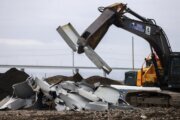WASHINGTON — The cleanup of a World War I chemical weapons testing site found under a house near American University will take almost three years longer than anticipated.
When the crucial and potentially risky step of excavating under the foundation began a year ago, the U.S. Army Corps of Engineers estimated the project would be restored to residential standards by the end of this year.
Now, the Army Corps tells WTOP neighbors in the pricey Spring Valley neighborhood have been told the project likely won’t be completed until spring 2017.
“Overall, we’ve seen several schedule delays,” says Brenda Barber, project manager for the Army Corps of Engineers Spring Valley cleanup. “A lot has been on the amount of debris we’ve encountered, in addition to some site conditions based on how the house was constructed.”
The house at 4825 Glenbrook Rd. NW was removed in 2012, after investigations dating back to 2000.
The Spring Valley project began in 1993, when a contractor unearthed buried military ordnance on nearby 52nd Court NW.
Click on the gallery to see images of items uncovered in the Spring Valley munitions cleanup
Barber says in the year since the digging began under the foundation, crews have discovered 39 intact glass containers.
“The containers did contain amounts of mustard and lewisite, in addition to other industrial compounds that were used here at the experiment station during World War One,” says Barber.
Mustard gas and lewisite — an arsenic-containing blister agent — were used in chemical weapons during World War I.
Despite the dangerous chemicals involved, Barber says neighbors were not at risk from the discovery of the glassware.
“They were intact, so the liquids were contained inside,” says Barber. “There was no risk to the residents.”
Barber says that during the so-called “high probability” dig under the home, real-time monitoring has detected dangerous gases inside the huge tent which covers the area where crews are digging.
“The engineering control structure is under negative pressure at all times, and the chemical agent filtration systems process and treat all the air that’s being pulled from the tent,” says Barber. “So, if there’s an active release going on, those systems are in place to protect the public.”
In cases where monitors inside the tent determine a release, crews cover the area being excavated to stop the release, then wait for air monitoring to clear before resuming the dig and packaging the contaminated materials for disposal, says Barber.
Barber says the elaborate monitoring system has prevented any leaks of dangerous substances into Spring Valley air.
“It has shown there has been no release to the public at any time during our operations here at the site,” says Barber.
The slow-but-steady skimming of soil has continued down to solid bedrock.
“We did confirmation sampling on the floor of the excavation, and all the confirmation samples showed there was no contamination left,” says Barber.
With that portion remediated, crews are now moving the enclosure to begin the second of three excavation zones.
The Army Corps of Engineers now estimates the project could be completed by early 2017.
Related story:







